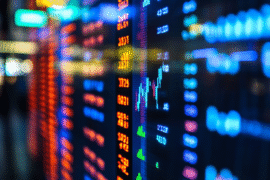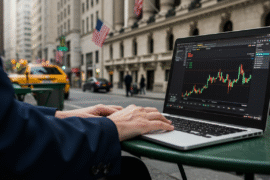This article may contain references to products or services from one or more of our advertisers or partners. We may receive compensation when you click on links to those products or services. Nonetheless, our opinions are our own.
The information presented in this article is accurate to the best of our knowledge at the time of publication. However, information is subject to change, and no guarantees are made about the continued accuracy or completeness of this content after its publication date.
- Trade Uncertainty and Its Influence on Stock Markets
- The Connection Between Trade Uncertainty and Stock Prices
- Investment Strategies for Navigating Trade-Driven Volatility
- Following Market Trends and Economic Indicators
- Adapting to Market Shifts with a Long-Term Perspective
- Conclusion
- Frequently Asked Questions
- Recommended Reads
Trade Uncertainty and Its Influence on Stock Markets
Economic landscapes are rarely stable, and uncertainty is one of the most powerful forces that shape financial markets, especially when it comes to international trade policies. Trade fights, changing tariffs, and talks between big economies can all have effects on stock markets, making them unstable and affecting businesses, investors, and banks. This conversation looks at how trade uncertainty affects stock prices, which sectors are most affected by policy changes, and how investors can get ready for possible changes in the market.
The Connection Between Trade Uncertainty and Stock Prices
Market Volatility
Uncertainty surrounding trade policies often results in unpredictable market movements. When new tariffs or trade restrictions are proposed, investors react swiftly, adjusting portfolios to account for potential risks. Stock prices can fluctuate significantly as traders attempt to assess how policy changes will affect corporate profits, supply chains, and economic growth. For example, during trade tensions between the U.S. and China in 2018 and 2019, the stock market experienced multiple periods of decline, particularly in industries with global supply chains. Market sentiment often shifts in response to new policy announcements, with investors favoring more stable assets when trade negotiations seem uncertain.
Industries Most Affected by Trade Uncertainty
Not all industries respond to trade uncertainty in the same way. While some sectors are hit hard by new tariffs or restrictions, others remain relatively insulated.
| Sector | Effects of Trade Uncertainty |
|---|---|
| Technology | Higher tariffs on components raise production costs. |
| Manufacturing | Reduced demand for exports due to trade barriers. |
| Agriculture | Retaliatory tariffs limit market access for farmers. |
| Consumer Staples | Less affected; demand remains stable. |
Companies that rely heavily on international supply chains often see increased costs and decreased profit margins when trade barriers arise. In contrast, businesses focused on domestic production and consumption may experience fewer negative effects or even benefit from shifting trade policies.
Currency Markets and Trade Policy
Currency values also fluctuate in response to trade uncertainty. When trade disputes arise, investors frequently turn to historically stable assets, such as the U.S. dollar, gold, or government bonds. But a stronger U.S. dollar can make American exports more expensive in global markets, creating additional challenges for companies that rely on foreign consumers. For example, in 2019, the U.S. dollar appreciated amid heightened trade tensions, making it more difficult for multinational corporations to compete internationally.
Balancing a Portfolio for Stability
One of the best ways to deal with market swings related to trade is to diversify. Investors lower their risk by spreading their money across different types of assets, such as stocks, bonds, and commodities.
Some defensive investments that tend to perform well in uncertain market conditions include:
- Consumer Staples (grocery and household goods companies)
- Healthcare (pharmaceutical and medical service providers)
- Utilities (electric, water, and gas providers)
These industries often see steady demand regardless of economic shifts, making them more resilient during trade-related volatility.
Voted "Best Overall Budgeting App" by Forbes and WSJ
Monarch Money helps you budget, track spending, set goals, and plan your financial future—all in one app.
Get 50% OFF your first year with code MONARCHVIP
Following Market Trends and Economic Indicators
You need to know what’s going on in the economy and the trade in order to make smart investment decisions. You can get an idea of how the market might change by looking at things like manufacturing output, export levels, and corporate earnings reports. For example, if new trade rules put a major export industry at risk, investors might expect stocks in that industry to do worse and change their portfolios to reflect that. But when people see signs of trade agreements or lower tariffs, they may feel better about the market, which can make stock prices go back up in industries that are affected.
Adapting to Market Shifts with a Long-Term Perspective
While trade uncertainty can create short-term instability, it also opens opportunities for investors willing to take a disciplined, informed approach. Avoiding reactive decision-making and focusing on long-term financial goals can help mitigate the risks associated with market fluctuations. By maintaining a well-diversified portfolio, investing in stable industries, and keeping a close watch on economic trends, investors can better navigate market challenges. Instead of viewing uncertainty as a threat, knowing its impact can transform it into a potential advantage.
Conclusion
Trade uncertainty is a big reason why the market is so volatile and why stock prices go up and down. This is especially true when it comes to international trade policies. Tariffs, trade restrictions, and economic negotiations are always changing, and these changes can affect many areas of the economy. This can be both good and bad for businesses, investors, and policymakers. Trade uncertainty affects some sectors more than others. For example, technology, manufacturing, and agriculture are more likely to be affected than consumer staples and healthcare. Investors need to be aware that there is a chance of volatility when trade is uncertain. But if you have a diversified portfolio, think about investing for the long term, and know how to read economic indicators, you can handle market changes with strength. Accepting volatility as a normal part of investing and staying flexible can help you make the most of these uncertain times and grow your business strategically. As trade patterns change, it’s important to stay informed and flexible in order to manage financial risk and get the most out of possible rewards.
Frequently Asked Questions
How does trade uncertainty affect stock prices?
When investors think about how tariffs, trade restrictions, or changes in trade policy might affect the market, stock prices can go up and down. When new trade rules are announced, stock prices may drop, especially in sectors that rely on global supply chains, as investors change their expectations for how much money companies will make and how stable the market will be.
Which sectors are most affected by trade uncertainty?
Changes in trade policy can have a big effect on industries that depend on international trade, such as technology, manufacturing, and agriculture. Higher tariffs or trade barriers can raise production costs, lower demand for exports, and make it harder for businesses to get into markets, which can hurt profits in these fields. But trade uncertainty doesn’t usually affect sectors like consumer staples and utilities that provide basic goods and services.
How do currency markets respond to trade uncertainty?
When there is uncertainty in the markets, currency values can change a lot. Changes in currency values can happen when investors look for safe-haven assets like the U.S. dollar, gold, or government bonds. For example, a stronger dollar can make U.S. goods more expensive to sell abroad, which could make it harder for multinational companies to compete there.
By spreading your investments across different asset classes, like stocks, bonds, and commodities, you can lower the risk of market swings caused by trade uncertainty. When things are uncertain, defensive stocks in industries like utilities, healthcare, and consumer staples tend to do well. Following market signals and economic trends, like corporate earnings reports and manufacturing output, can also help you make smart choices.
How can long-term investors manage trade uncertainty?
Long-term investors should keep their portfolios well-diversified, put money into industries that are stable, and stick to their investment plans. Investors can weather trade uncertainty and keep building wealth over time by not reacting too quickly to short-term changes and staying focused on their long-term financial goals.

Reviewed and edited by Albert Fang.
See a typo or want to suggest an edit/revision to the content? Use the contact us form to provide feedback.
At FangWallet, we value editorial integrity and open collaboration in curating quality content for readers to enjoy. Much appreciated for the assist.
Did you like our article and find it insightful? We encourage sharing the article link with family and friends to benefit as well - better yet, sharing on social media. Thank you for the support! 🍉
Article Title: Stocks Pressured by US Trade Uncertainty
https://fangwallet.com/2025/08/06/stocks-pressured-by-us-trade-uncertainty/The FangWallet Promise
FangWallet is an editorially independent resource - founded on breaking down challenging financial concepts for anyone to understand since 2014. While we adhere to editorial integrity, note that this post may contain references to products from our partners.
The FangWallet promise is always to have your best interest in mind and be transparent and honest about the financial picture.
Become an Insider

Subscribe to get a free daily budget planner printable to help get your money on track!
Make passive money the right way. No spam.
Editorial Disclaimer: The editorial content on this page is not provided by any of the companies mentioned. The opinions expressed here are the author's alone.
The content of this website is for informational purposes only and does not represent investment advice, or an offer or solicitation to buy or sell any security, investment, or product. Investors are encouraged to do their own due diligence, and, if necessary, consult professional advising before making any investment decisions. Investing involves a high degree of risk, and financial losses may occur including the potential loss of principal.
Source Citation References:
+ Inspo
Novy, D., & Taylor, A. M. (2020). Trade and uncertainty. Review of Economics and Statistics, 102(4), 749-765.












































